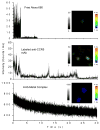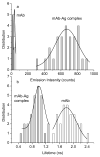Direct observation to chemokine receptor 5 on T-lymphocyte cell surface using fluorescent metal nanoprobes
- PMID: 20705055
- PMCID: PMC2944233
- DOI: 10.1016/j.bbrc.2010.08.020
Direct observation to chemokine receptor 5 on T-lymphocyte cell surface using fluorescent metal nanoprobes
Abstract
Chemokine receptor 5 (CCR5) is a cell surface protein required for HIV-1 infection. It is important to detect the amount and observe the spatial distribution of the CCR5 receptors on the cell surfaces. In this report, we describes the metal nanoparticles which were specially designed as molecular fluorescent probes for imaging of CCR5 receptors on the T-lymphocytic PM1 cell surfaces. These CCR5 monoclonal antibodies (mAbs) metal complexes were prepared by labeling mAbs with Alexa Fluor 680 followed by covalent binding the labeled mAbs on the 20 nm silver nanoparticles. Compared with the labeled mAbs without metal, the mAb-metal complexes were found to display enhanced emission intensity and shortened lifetime due to interactions between fluorophores and metal. The mAb-metal complexes were incubated with the PM1 cell lines. The confocal fluorescent intensity and lifetime cell images were recorded on single cells. It was observed that the mAb-metal complexes could be clearly distinguished from the cellular autofluorescence. By analyzing a pool of cell images, we observed that most CCR5 receptors appeared as clusters on the cell surfaces. The fluorophore-metal complexes developed in this report are generally useful for detection of cell surface receptors and provide a new class of probe to study the interaction between the CCR5 receptors with viral gp120 during HIV infections.
Copyright © 2010 Elsevier Inc. All rights reserved.
Figures




Similar articles
-
Direct observation of chemokine receptors 5 on T-lymphocyte cell surfaces using fluorescent metal nanoprobes 2: Approximation of CCR5 populations.Biochem Biophys Res Commun. 2011 Apr 1;407(1):63-7. doi: 10.1016/j.bbrc.2011.02.104. Epub 2011 Feb 26. Biochem Biophys Res Commun. 2011. PMID: 21356199 Free PMC article.
-
Fluorescent avidin-bound silver particle: a strategy for single target molecule detection on a cell membrane.Anal Chem. 2009 Feb 1;81(3):883-9. doi: 10.1021/ac801932m. Anal Chem. 2009. PMID: 19113832 Free PMC article.
-
Interaction of chemokine receptor CCR5 with its ligands: multiple domains for HIV-1 gp120 binding and a single domain for chemokine binding.J Exp Med. 1997 Oct 20;186(8):1373-81. doi: 10.1084/jem.186.8.1373. J Exp Med. 1997. PMID: 9334377 Free PMC article.
-
Differential inhibition of human immunodeficiency virus type 1 fusion, gp120 binding, and CC-chemokine activity by monoclonal antibodies to CCR5.J Virol. 1999 May;73(5):4145-55. doi: 10.1128/JVI.73.5.4145-4155.1999. J Virol. 1999. PMID: 10196311 Free PMC article.
-
Broadly cross-reactive HIV-1-neutralizing human monoclonal Fab selected for binding to gp120-CD4-CCR5 complexes.Proc Natl Acad Sci U S A. 2002 May 14;99(10):6913-8. doi: 10.1073/pnas.102562599. Epub 2002 May 7. Proc Natl Acad Sci U S A. 2002. PMID: 11997472 Free PMC article.
Cited by
-
Noble metal nanoparticles for biosensing applications.Sensors (Basel). 2012;12(2):1657-87. doi: 10.3390/s120201657. Epub 2012 Feb 7. Sensors (Basel). 2012. PMID: 22438731 Free PMC article. Review.
-
Fluorescence Intensity and Lifetime Cell Imaging with Luminescent Gold Nanoclusters.J Phys Chem C Nanomater Interfaces. 2012 Dec 20;116(50):10.1021/jp306036y. doi: 10.1021/jp306036y. J Phys Chem C Nanomater Interfaces. 2012. PMID: 24363815 Free PMC article.
-
A superior bright NIR luminescent nanoparticle preparation and indicating calcium signaling detection in cells and small animals.Cell Biosci. 2018 Jun 5;8:37. doi: 10.1186/s13578-018-0235-1. eCollection 2018. Cell Biosci. 2018. PMID: 29928497 Free PMC article.
-
Fluorescent metal nanoshell and CK19 detection on single cell image.Biochem Biophys Res Commun. 2011 Sep 16;413(1):53-7. doi: 10.1016/j.bbrc.2011.08.042. Epub 2011 Aug 17. Biochem Biophys Res Commun. 2011. PMID: 21867692 Free PMC article.
-
Metal-Enhanced Fluorescence from Silver Nanowires with High Aspect Ratio on Glass Slides for Biosensing Applications.J Phys Chem C Nanomater Interfaces. 2015 Jan 8;119(1):675-684. doi: 10.1021/jp509040f. Epub 2014 Dec 10. J Phys Chem C Nanomater Interfaces. 2015. PMID: 25598859 Free PMC article.
References
-
- Dragic T, Litwin V, Allaway GP, Martin SR, Huang YX, Nagashima KA, Cayanan C, Maddon PJ, Koup RA, Moore JP, Paxton WA. HIV-1 entry into CD4+ cells is mediated by the chemokine receptor CC-CKR-5. Nature. 1996;381:667–673. - PubMed
-
- Huang Y, Paxton WA, Wolinsky SM, Neumann AU, Zhang L, He T, Kang S, Ceradini D, Jin Z, Yazdanbakhsh K, Kunstman K, Erickson D, Dragon E, Landau NR, Phair J, Ho DD, Koup RA. The role of a mutant CCR 5 allele in HIV-1 transmission and disease progression. Nat Med. 1996;2:1240–1243. - PubMed
Publication types
MeSH terms
Substances
Grants and funding
LinkOut - more resources
Full Text Sources

